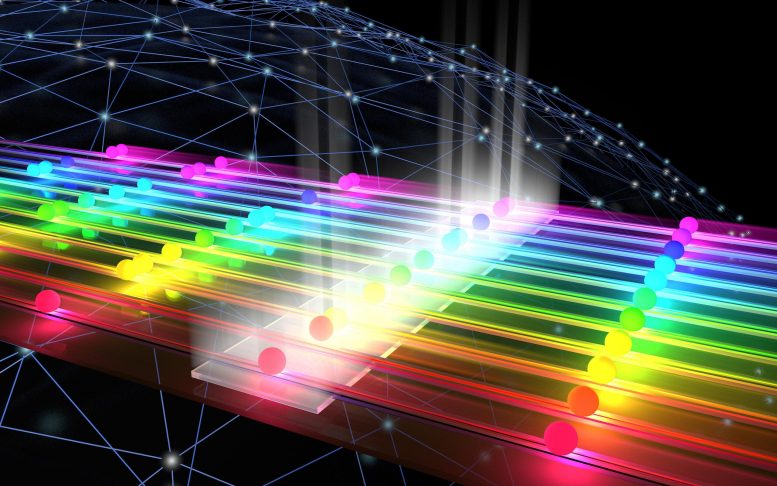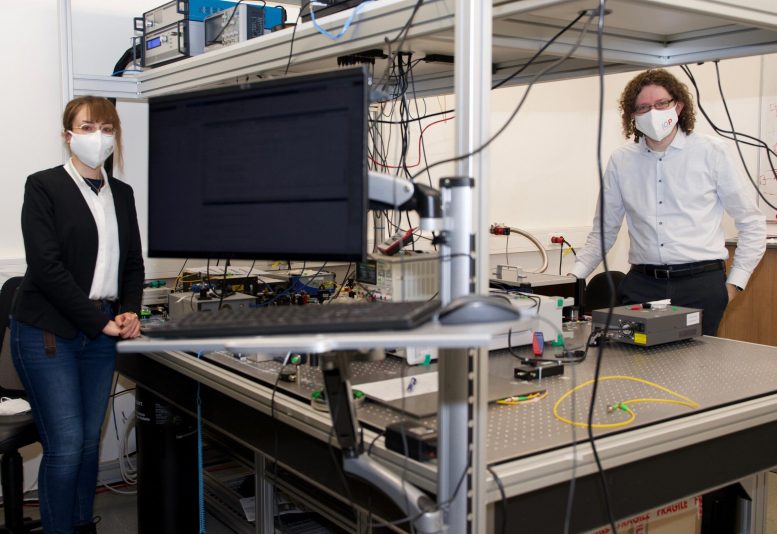
Researchers demonstrate a novel photonic interference effect that could pave the way to large-scale controllable quantum systems.
It’s another step on the road to developing quantum information processing applications. A key experiment succeeded in going beyond the previously defined limits for photon applications. Anahita Khodadad Kashi and Prof. Dr. Michael Kues from the Institute of Photonics and the Cluster of Excellence PhoenixD at Leibniz University Hannover (Germany) have demonstrated a novel interference effect. The scientists have thus shown that new color-coded photonic networks can be tapped, and the number of photons involved, i.e. light particles, can be scaled. “This discovery could enable new benchmarks in quantum communication, computational operations of quantum computers as well as quantum measurement techniques and is feasible with existing optical telecommunication infrastructure,” says Kues.
The decisive experiment was successfully performed in the newly established “Quantum Photonics Laboratory (QPL)” of the Institute of Photonics and the Hannover Centre for Optical Technologies at Leibniz University Hannover. Anahita Khodadad Kashi succeeded in quantum-mechanically interfering independently generated pure photons with different colors, i.e. frequencies. Khodadad Kashi detected a so-called Hong-Ou-Mandel effect.
Hong-Ou-Mandel interference is a fundamental effect of quantum optics that forms the basis for many quantum information processing applications — from quantum computing to quantum metrology. The effect describes how two photons behave when they collide on a spatial beam splitter and explains the phenomenon of quantum mechanical interference.

The researchers have now realized a frequency beamsplitter using telecommunications components and demonstrate the Hong-Ou-Mandel effect for the first time between two independently generated photons in the frequency domain. In contrast to other dimensions, such as the polarisation (oscillation plane of the electric field) or the photon’s position (spatial localization), the frequency is much less susceptible to interference. “Our approach allows flexible configurability and access to high-dimensional systems, which may lead to large-scale controllable quantum systems in the future,” says Kues. This two-photon interference phenomenon can serve as a foundation for a quantum internet, non-classical communication and quantum computers. In other words, the results could be used for frequency-based quantum networks. Another notable feature of the new discovery is that this increase in performance could be used with existing infrastructure, i.e. standard fiber optic connections for connecting to the internet. The use of quantum technologies at home could thus theoretically be made possible in the future.
“I was very pleased that our experiment was able to demonstrate the Hong-Ou-Mandel effect in the frequency domain,” says Khodadad Kashi. The researcher moved to Hannover in 2019 after completing her master’s degree in electrical engineering, focusing on photonics at Iran University of Science and Technology in Tehran. Since then, she has strengthened Prof. Kues’ team of seven. Kues has been a professor at Leibniz University Hannover since spring 2019 and is researching the development of photonic quantum technologies using micro-and nanophotonics in the Cluster of Excellence PhoenixD. In the future, Kashi and Kues will continue their research on the topic of spectral Hong-Ou-Mandel interference. “I would like to extend the current experiment to exploit the demonstrated effect for quantum information processing,” says Khodadad Kashi.
The scientific journal Laser & Photonics Reviews publishes the research results first. The research was part of the Quantum Futur project “PQuMAL” (Photonic Quantum Circuits for Machine Learning) funded by the German Federal Ministry of Education and Research (BMBF).
Reference: “Spectral Hong–Ou–Mandel Interference between Independently Generated Single Photons for Scalable Frequency‐Domain Quantum Processing” by Anahita Khodadad Kashi and Michael Kues, 18 March 2021, Laser & Photonics Reviews.
DOI: 10.1002/lpor.202000464
2 Comments
Thank you for all
Best Regards
Spooky interactions from a distance….. going to change everything the way we look at everything in life…..we are ready to advance 💙😇